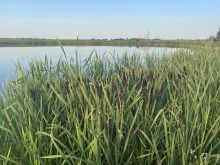Prairie pulse growers are finding weed relief in a unlikely corner of the herbicide universe -Group 14.
Until recently, producers had few options when trying to control broadleaf weeds.
However, a carfentrazone-ethyl and glyphosate tank mixture known as Clean Start became available last spring to control volunteer Roundup Ready canola chickpeas.
Carfentrazone is a Group 14 herbicide, a family that until now hasn’t played much of a weed control role in Western Canada.
The chemical impedes a photosynthetic metabolic process and eventually causes plant cell membranes to break down and weep out their fluids, desiccating the target plant.
Read Also

Europe holds promise for Canadian lentils
Pulse Canada is trying to help boost lentil consumption in Europe, which is already the fourth largest market.
The carfentrazone-glyphosate combination resulted in more rapid burn down in kochia and was effective on volunteer canola up to the four leaf stage.
Sulfentrazone, another Group 14 herbicide, is expected to become available next spring.
“It’s proving very effective on kochia,” said Eric Johnson, a weed biologist with Agriculture Canada’s research farm near Scott, Sask.
“Russian thistle, lambs quarters and wild buckwheat don’t care for it either.”
The product, which has not yet received a brand name in Canada, is the result of work that Agriculture Canada did with a product manufactured by American chemical maker FMC.
While it won’t solve broadleaf problems in lentils, it may be effective in chickpeas, fababeans and field peas.
Kochia has been one of the hardest to control weeds in those crops and thrives under minimum tillage.
Group 2 herbicide tolerance in kochia is making control more difficult, but sulfentrazone might provide solutions.
It is less effective in controlling wild mustard and stinkweed, but Johnson said Agriculture Canada is working on tank mix formulations that show promise.
“We’ve got a couple of new products that are in the pipeline that should be up for registration in a couple of years,” he said.
“I expect they’ll take care of most of the broadleaf (weed) problems.”
Sulfentrazone is soil applied during spring burn off and has significant residual effects, but federal researchers said the application rates for various soil compositions have been well examined.
Lentil and pinto bean growers will have to be careful, however, because those crops don’t do well if they come into contact with sulfentrazone, even two years after it has been used on an earlier crop.
While these two new products will provide relief for growers, other crops, including flax, continue to face limited options.
Red root pigweed often can get a good start after Buctril M has been applied to a young flax crop.
The residual effects of sulfentrazone applied at burn off provide excellent control of kochia and red root pigweed well into the growing season. Johnson hoped it will soon work for flax growers as well.
He said lentils are still a challenge, but researchers are making progress.
He said he has noticed more activity on minor use crops by pesticide manufacturers in the past year.
“I am hopeful this means more products reaching pulse growers,” he said.
“In reality if it didn’t work in soybeans, wheat, corn or rice, it wasn’t part of the big company’s research.”
Researchers said Agriculture Canada’s work on these two Group 14 products should be credited with their registrations.














